Financial Management Report: Financial Decisions and Government Aid
VerifiedAdded on 2020/02/05
|10
|2796
|62
Report
AI Summary
This report provides a comprehensive analysis of financial management, emphasizing its core purpose and implications from a shareholder's perspective. It delves into the three main financial decisions: investment, financing, and dividend decisions, illustrating their impact on shareholder wealth maximization. The report also discusses the critical need for government assistance in the business sector, exploring its various forms, such as financial aid and administrative support, and examining its interaction with business planning and decision-making processes. The report highlights both the positive and negative impacts of government involvement, considering aspects like green policies and externalities. The report concludes by acknowledging the role of government assistance in supporting businesses, particularly SMEs, during economic downturns, while also addressing potential limitations related to government intervention and political influences. This report is a valuable resource for understanding the intricate relationship between financial management, shareholders, and government support in fostering business success.

FINANCIAL MANAGEMENT
Paraphrase This Document
Need a fresh take? Get an instant paraphrase of this document with our AI Paraphraser
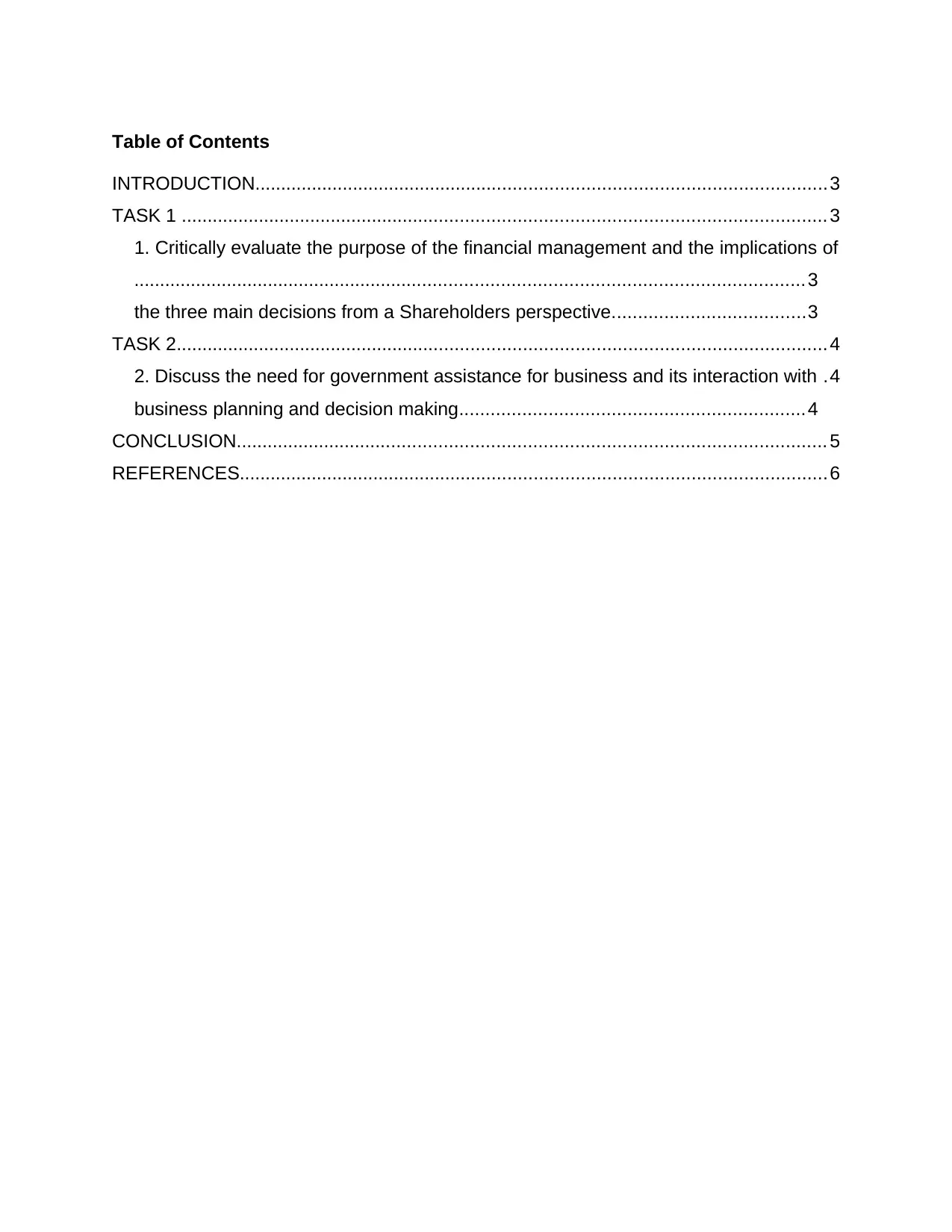
Table of Contents
INTRODUCTION..............................................................................................................3
TASK 1 ............................................................................................................................ 3
1. Critically evaluate the purpose of the financial management and the implications of
................................................................................................................................. 3
the three main decisions from a Shareholders perspective.....................................3
TASK 2.............................................................................................................................4
2. Discuss the need for government assistance for business and its interaction with .4
business planning and decision making..................................................................4
CONCLUSION................................................................................................................. 5
REFERENCES.................................................................................................................6
INTRODUCTION..............................................................................................................3
TASK 1 ............................................................................................................................ 3
1. Critically evaluate the purpose of the financial management and the implications of
................................................................................................................................. 3
the three main decisions from a Shareholders perspective.....................................3
TASK 2.............................................................................................................................4
2. Discuss the need for government assistance for business and its interaction with .4
business planning and decision making..................................................................4
CONCLUSION................................................................................................................. 5
REFERENCES.................................................................................................................6
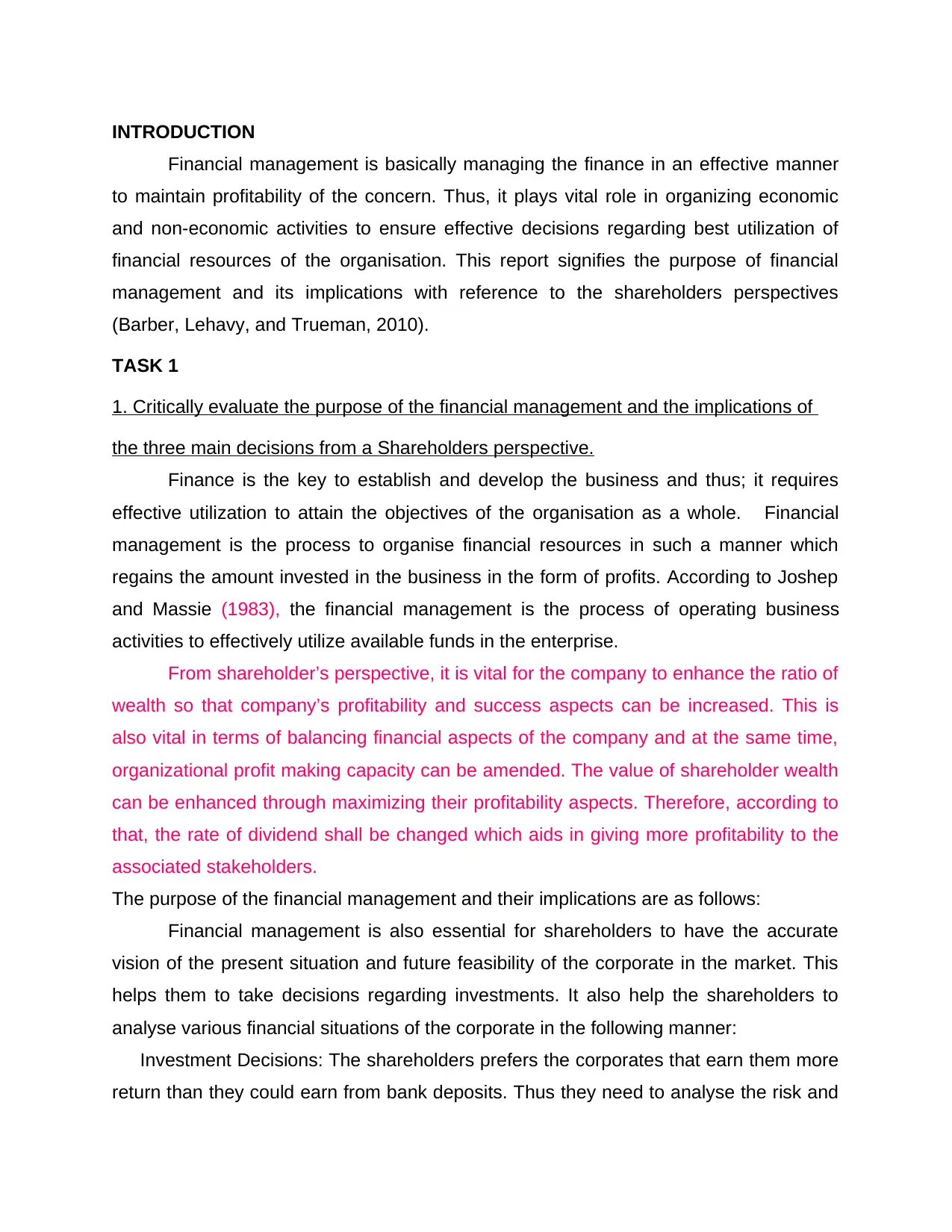
INTRODUCTION
Financial management is basically managing the finance in an effective manner
to maintain profitability of the concern. Thus, it plays vital role in organizing economic
and non-economic activities to ensure effective decisions regarding best utilization of
financial resources of the organisation. This report signifies the purpose of financial
management and its implications with reference to the shareholders perspectives
(Barber, Lehavy, and Trueman, 2010).
TASK 1
1. Critically evaluate the purpose of the financial management and the implications of
the three main decisions from a Shareholders perspective.
Finance is the key to establish and develop the business and thus; it requires
effective utilization to attain the objectives of the organisation as a whole. Financial
management is the process to organise financial resources in such a manner which
regains the amount invested in the business in the form of profits. According to Joshep
and Massie (1983), the financial management is the process of operating business
activities to effectively utilize available funds in the enterprise.
From shareholder’s perspective, it is vital for the company to enhance the ratio of
wealth so that company’s profitability and success aspects can be increased. This is
also vital in terms of balancing financial aspects of the company and at the same time,
organizational profit making capacity can be amended. The value of shareholder wealth
can be enhanced through maximizing their profitability aspects. Therefore, according to
that, the rate of dividend shall be changed which aids in giving more profitability to the
associated stakeholders.
The purpose of the financial management and their implications are as follows:
Financial management is also essential for shareholders to have the accurate
vision of the present situation and future feasibility of the corporate in the market. This
helps them to take decisions regarding investments. It also help the shareholders to
analyse various financial situations of the corporate in the following manner:
Investment Decisions: The shareholders prefers the corporates that earn them more
return than they could earn from bank deposits. Thus they need to analyse the risk and
Financial management is basically managing the finance in an effective manner
to maintain profitability of the concern. Thus, it plays vital role in organizing economic
and non-economic activities to ensure effective decisions regarding best utilization of
financial resources of the organisation. This report signifies the purpose of financial
management and its implications with reference to the shareholders perspectives
(Barber, Lehavy, and Trueman, 2010).
TASK 1
1. Critically evaluate the purpose of the financial management and the implications of
the three main decisions from a Shareholders perspective.
Finance is the key to establish and develop the business and thus; it requires
effective utilization to attain the objectives of the organisation as a whole. Financial
management is the process to organise financial resources in such a manner which
regains the amount invested in the business in the form of profits. According to Joshep
and Massie (1983), the financial management is the process of operating business
activities to effectively utilize available funds in the enterprise.
From shareholder’s perspective, it is vital for the company to enhance the ratio of
wealth so that company’s profitability and success aspects can be increased. This is
also vital in terms of balancing financial aspects of the company and at the same time,
organizational profit making capacity can be amended. The value of shareholder wealth
can be enhanced through maximizing their profitability aspects. Therefore, according to
that, the rate of dividend shall be changed which aids in giving more profitability to the
associated stakeholders.
The purpose of the financial management and their implications are as follows:
Financial management is also essential for shareholders to have the accurate
vision of the present situation and future feasibility of the corporate in the market. This
helps them to take decisions regarding investments. It also help the shareholders to
analyse various financial situations of the corporate in the following manner:
Investment Decisions: The shareholders prefers the corporates that earn them more
return than they could earn from bank deposits. Thus they need to analyse the risk and
⊘ This is a preview!⊘
Do you want full access?
Subscribe today to unlock all pages.

Trusted by 1+ million students worldwide

the return associated with the investments made by the corporates in the assets to
ensure the maximising the value of the corporate as a whole. This is possible through
calculating pay back period, annual rate of return method, internal rate of return method
etc. The value of payback needs to be shorter as compared to the investment project as
that only denotes the chances of greater profitability. At the same time, it also
demonstrates that business has the capability to generate much profitability in the same
investment amount. Net Present Value of the investment should always be optimistic
since that shows the capacity of generating more profits and success. Similarly, in this
context it is also crucial for the business entity to enhance the internal rate of return
because it is related to retaining the interest of stakeholders for longer time span.
Financing decisions: Financing decisions refers to capital structure of the corporate
which includes both internal and external sources of finance. The shareholders need to
analyse the capital structure mix to ensure the optimum utilization of both the resources
through various debt to assets ratios to calculate the financial risk and business risk.
Thus the financial management plays vital role in this aspect too.
Dividend Decisions: Financial management also helps the shareholders to analyse
the amount that is left with the corporate after all the debts and taxes paid off to pay the
dividends to its owners. Financial management also facilitate the decisions regarding
buy back of shares and declaration of the dividends keeping in mind the current
opportunities of huge investments and the returns associated with it. It also considers
various dividend policies like Gorden's Dividend Policy which helps to value the
company's stock using the assumption that there is the constant growth in the corporate
which facilitates the shareholders to ensure regular dividend distribution.
It is essential for the business entity to emphasize on proper proportionate
among equity and debt as that can only change the financial structure. There must be
optimal capital structure so that financial capacity of the business can be strengthened.
There must be minimum risk in the business resources so that the capacity of return
can be amended (Barber, Lehavy and Trueman, 2010). High rate of return for the
shareholders will not only retain them; but also it will maximize the resource capability of
business entity.
ensure the maximising the value of the corporate as a whole. This is possible through
calculating pay back period, annual rate of return method, internal rate of return method
etc. The value of payback needs to be shorter as compared to the investment project as
that only denotes the chances of greater profitability. At the same time, it also
demonstrates that business has the capability to generate much profitability in the same
investment amount. Net Present Value of the investment should always be optimistic
since that shows the capacity of generating more profits and success. Similarly, in this
context it is also crucial for the business entity to enhance the internal rate of return
because it is related to retaining the interest of stakeholders for longer time span.
Financing decisions: Financing decisions refers to capital structure of the corporate
which includes both internal and external sources of finance. The shareholders need to
analyse the capital structure mix to ensure the optimum utilization of both the resources
through various debt to assets ratios to calculate the financial risk and business risk.
Thus the financial management plays vital role in this aspect too.
Dividend Decisions: Financial management also helps the shareholders to analyse
the amount that is left with the corporate after all the debts and taxes paid off to pay the
dividends to its owners. Financial management also facilitate the decisions regarding
buy back of shares and declaration of the dividends keeping in mind the current
opportunities of huge investments and the returns associated with it. It also considers
various dividend policies like Gorden's Dividend Policy which helps to value the
company's stock using the assumption that there is the constant growth in the corporate
which facilitates the shareholders to ensure regular dividend distribution.
It is essential for the business entity to emphasize on proper proportionate
among equity and debt as that can only change the financial structure. There must be
optimal capital structure so that financial capacity of the business can be strengthened.
There must be minimum risk in the business resources so that the capacity of return
can be amended (Barber, Lehavy and Trueman, 2010). High rate of return for the
shareholders will not only retain them; but also it will maximize the resource capability of
business entity.
Paraphrase This Document
Need a fresh take? Get an instant paraphrase of this document with our AI Paraphraser

Financial management helps to take effective investment decisions through
various techniques like money value discount factor, economic order quantity,
net present value etc. It helps to ensure feasibility of every project which needs
to be established by the corporate before investing high in the project. . Thus,
every corporate is required to present the feasibility report prepared by the
financial manager in the Board meeting to get it approved by the shareholders.
Because the financial report by the financial manager is one of the credible report
in eyes of all shareholders (Brigham, and Ehrhardt, 2013).
Financial management is also very effective in decisions regarding production
and the operational activities because production department requires high
investment in the form of raw materials, machinery, wages etc. Thus,
manufacturing companies needs to plan and estimate the amount to allocate the
same in the production department. . High investment on machinery which have
direct impact on Total Assets of the company need the approval of shareholders
which again requires the feasibility report on the same.
Financial management is necessary for the organisation to estimate financial
requirements of the company to acquire the fixed assets and to meet the working
capital requirements. These requirements are need not be fulfilled by the internal
sources of finance thus external sources like banks, financial institutions,
shareholders through IPO are invited to invest in the corporate organisations.
These shareholders likes to invest their earning money in the corporate which
assures them to return their hard earn money with interests. (Brigham, and
Houston, 2012). Thus, they analyse the financial position of the company through
financial report prepared by the financial manager as they have faith on its
credibility. Thus, the financial manger need to forecast and prepare financial
statements like ratio analysis, find flow statement , cash flow statement, Balance
Sheet and income statement to enhance credibility of the corporate in the
market.
Financial management is the essential element to manage corporate finance but it is
based on the forecast which is not accurate and these financial reports can be easily
various techniques like money value discount factor, economic order quantity,
net present value etc. It helps to ensure feasibility of every project which needs
to be established by the corporate before investing high in the project. . Thus,
every corporate is required to present the feasibility report prepared by the
financial manager in the Board meeting to get it approved by the shareholders.
Because the financial report by the financial manager is one of the credible report
in eyes of all shareholders (Brigham, and Ehrhardt, 2013).
Financial management is also very effective in decisions regarding production
and the operational activities because production department requires high
investment in the form of raw materials, machinery, wages etc. Thus,
manufacturing companies needs to plan and estimate the amount to allocate the
same in the production department. . High investment on machinery which have
direct impact on Total Assets of the company need the approval of shareholders
which again requires the feasibility report on the same.
Financial management is necessary for the organisation to estimate financial
requirements of the company to acquire the fixed assets and to meet the working
capital requirements. These requirements are need not be fulfilled by the internal
sources of finance thus external sources like banks, financial institutions,
shareholders through IPO are invited to invest in the corporate organisations.
These shareholders likes to invest their earning money in the corporate which
assures them to return their hard earn money with interests. (Brigham, and
Houston, 2012). Thus, they analyse the financial position of the company through
financial report prepared by the financial manager as they have faith on its
credibility. Thus, the financial manger need to forecast and prepare financial
statements like ratio analysis, find flow statement , cash flow statement, Balance
Sheet and income statement to enhance credibility of the corporate in the
market.
Financial management is the essential element to manage corporate finance but it is
based on the forecast which is not accurate and these financial reports can be easily

manipulated by the financial managers to show the good position of company in the
market (Chandra, 2011).
TASK 2
2. Discuss the need for government assistance for business and its interaction with
business planning and decision making
Government assistance means various aids, benefits granted by the government
to encourage and enhance business economy which directly enhance the economy of
the country and its GDP and per capita income of every individual. Government grants
these aids to the business sector to establish new ventures in the country thus they
have direct or indirect control over these establishments. The certain benefits of the
government assistance in the business are as follows:
For instance- Government can allow the business entities to get financial
assistance from different funding bodies and financial institutions. This can also assist
the business entity to regulate all the functions in effectual way. In terms of financial
assistance- government can also reduce the rate of interest so that business entities
can find out new opportunities to manage financial aspects (Parker, 2012).
It provides the initial small funding to start the business venture which is also
called the crow funding that attracts the small entrepreneurs who have the
innovative idea but due to lack of financial resources they can implement their
idea .
Government also helps the scalable business entrepreneurs to develop the
sustainable relationship with the business angels because the government act as
guarantor for them and business angels can easily invest high in the future
projects (Brigham, and Ehrhardt, 2013). For instance- government can develop
prominent relationships with equity shareholders and other investors who
contribute more in making money and changing the financial aspects. This is also
crucial in terms of changing market value.
Government assistance can be of two types, one is financial help and other is
administrative help. State and local government ask the commercial and regional banks
to provide loans on small interest to new enterprises.
market (Chandra, 2011).
TASK 2
2. Discuss the need for government assistance for business and its interaction with
business planning and decision making
Government assistance means various aids, benefits granted by the government
to encourage and enhance business economy which directly enhance the economy of
the country and its GDP and per capita income of every individual. Government grants
these aids to the business sector to establish new ventures in the country thus they
have direct or indirect control over these establishments. The certain benefits of the
government assistance in the business are as follows:
For instance- Government can allow the business entities to get financial
assistance from different funding bodies and financial institutions. This can also assist
the business entity to regulate all the functions in effectual way. In terms of financial
assistance- government can also reduce the rate of interest so that business entities
can find out new opportunities to manage financial aspects (Parker, 2012).
It provides the initial small funding to start the business venture which is also
called the crow funding that attracts the small entrepreneurs who have the
innovative idea but due to lack of financial resources they can implement their
idea .
Government also helps the scalable business entrepreneurs to develop the
sustainable relationship with the business angels because the government act as
guarantor for them and business angels can easily invest high in the future
projects (Brigham, and Ehrhardt, 2013). For instance- government can develop
prominent relationships with equity shareholders and other investors who
contribute more in making money and changing the financial aspects. This is also
crucial in terms of changing market value.
Government assistance can be of two types, one is financial help and other is
administrative help. State and local government ask the commercial and regional banks
to provide loans on small interest to new enterprises.
⊘ This is a preview!⊘
Do you want full access?
Subscribe today to unlock all pages.

Trusted by 1+ million students worldwide

Some commercial banks also allows to pay the portion of defaulted loans of the
sick companies.
Government regulations also encourage large business organisations to support
the small businesses and in return enjoy the various tax benefits.
Government has also declared various tax benefits for the new business
ventures that they need not pay any taxes for 10 years on the profit gained by
them.
Governments have direct interaction with the corporate in the decision planning and
decision making which affect the company, economic values and its activities too. The
involvement of government has some positive impacts and some negative impacts on
the corporate which are as follows:
Green Policies: Green policies refers to the environmental policies that
safeguards the environment from the adverse effects. This green policy includes the No
Objection Certificate regarding the operations need to be performed by them in their
business venture. It also includes the effective usage of scrap and the disposal of the
wastage such that it do not harm the environment and use effective recycle methods
(Brigham and Houston, 2012).
Externalities: Externalities occurs when businesses entity produces the goods
that have direct impact on other sections of the society. It can be negative and positive.
Positive externalities refers to benefits the other people gain nearby for example the
business venture develop in the locality increase the land rates of whole community.
and negative externalities is the adverse effect of the pollution create by the goods
produced.
:
Government assistance in the form of high investment helps the corporate to
develop new infrastructure which ultimately leads to maximise profits of the
organisation and enhance economic value of the corporate in the market, The
corporate are not in the situation to invest their internal funds in the project as
they need to continue operational activities and maintain present position in the
sick companies.
Government regulations also encourage large business organisations to support
the small businesses and in return enjoy the various tax benefits.
Government has also declared various tax benefits for the new business
ventures that they need not pay any taxes for 10 years on the profit gained by
them.
Governments have direct interaction with the corporate in the decision planning and
decision making which affect the company, economic values and its activities too. The
involvement of government has some positive impacts and some negative impacts on
the corporate which are as follows:
Green Policies: Green policies refers to the environmental policies that
safeguards the environment from the adverse effects. This green policy includes the No
Objection Certificate regarding the operations need to be performed by them in their
business venture. It also includes the effective usage of scrap and the disposal of the
wastage such that it do not harm the environment and use effective recycle methods
(Brigham and Houston, 2012).
Externalities: Externalities occurs when businesses entity produces the goods
that have direct impact on other sections of the society. It can be negative and positive.
Positive externalities refers to benefits the other people gain nearby for example the
business venture develop in the locality increase the land rates of whole community.
and negative externalities is the adverse effect of the pollution create by the goods
produced.
:
Government assistance in the form of high investment helps the corporate to
develop new infrastructure which ultimately leads to maximise profits of the
organisation and enhance economic value of the corporate in the market, The
corporate are not in the situation to invest their internal funds in the project as
they need to continue operational activities and maintain present position in the
Paraphrase This Document
Need a fresh take? Get an instant paraphrase of this document with our AI Paraphraser
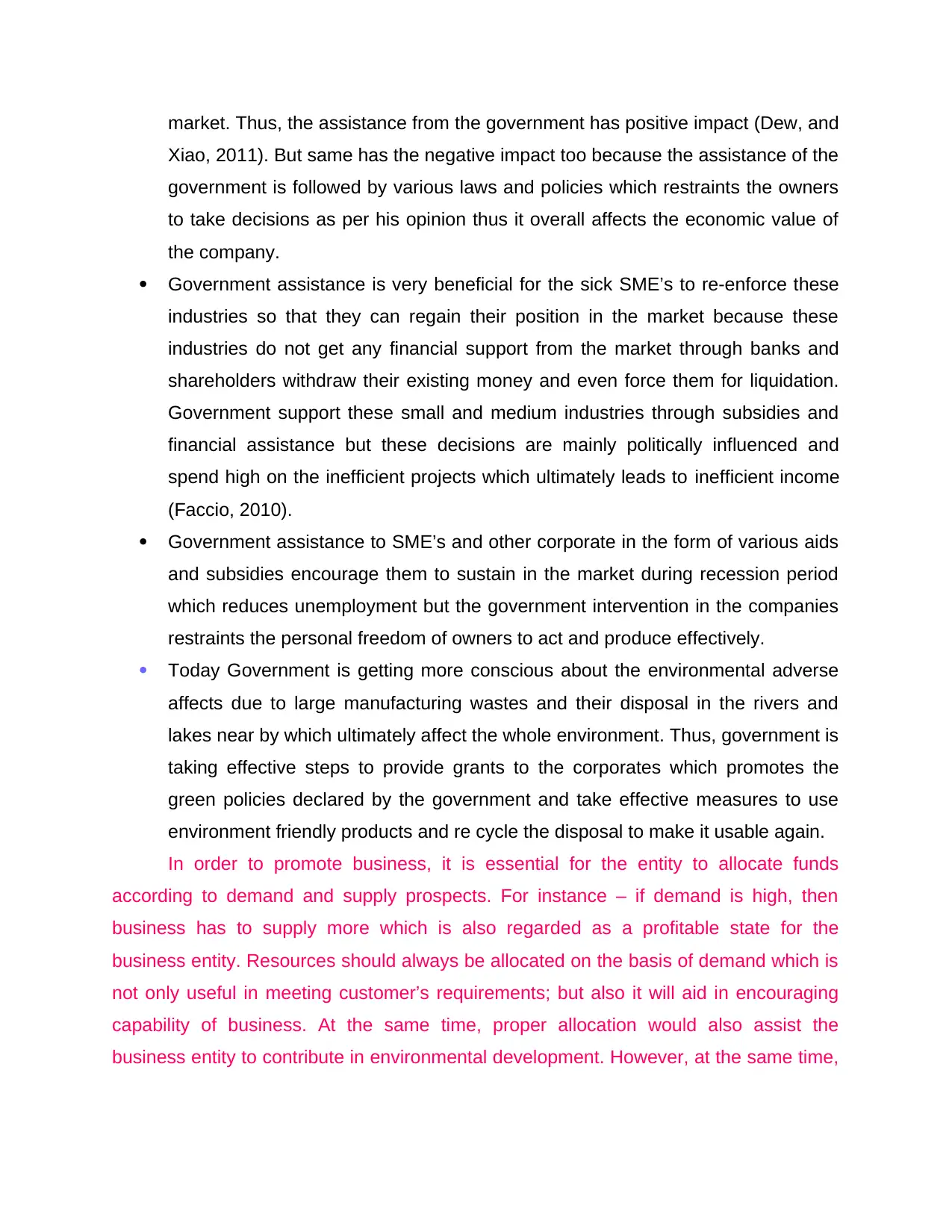
market. Thus, the assistance from the government has positive impact (Dew, and
Xiao, 2011). But same has the negative impact too because the assistance of the
government is followed by various laws and policies which restraints the owners
to take decisions as per his opinion thus it overall affects the economic value of
the company.
Government assistance is very beneficial for the sick SME’s to re-enforce these
industries so that they can regain their position in the market because these
industries do not get any financial support from the market through banks and
shareholders withdraw their existing money and even force them for liquidation.
Government support these small and medium industries through subsidies and
financial assistance but these decisions are mainly politically influenced and
spend high on the inefficient projects which ultimately leads to inefficient income
(Faccio, 2010).
Government assistance to SME’s and other corporate in the form of various aids
and subsidies encourage them to sustain in the market during recession period
which reduces unemployment but the government intervention in the companies
restraints the personal freedom of owners to act and produce effectively.
Today Government is getting more conscious about the environmental adverse
affects due to large manufacturing wastes and their disposal in the rivers and
lakes near by which ultimately affect the whole environment. Thus, government is
taking effective steps to provide grants to the corporates which promotes the
green policies declared by the government and take effective measures to use
environment friendly products and re cycle the disposal to make it usable again.
In order to promote business, it is essential for the entity to allocate funds
according to demand and supply prospects. For instance – if demand is high, then
business has to supply more which is also regarded as a profitable state for the
business entity. Resources should always be allocated on the basis of demand which is
not only useful in meeting customer’s requirements; but also it will aid in encouraging
capability of business. At the same time, proper allocation would also assist the
business entity to contribute in environmental development. However, at the same time,
Xiao, 2011). But same has the negative impact too because the assistance of the
government is followed by various laws and policies which restraints the owners
to take decisions as per his opinion thus it overall affects the economic value of
the company.
Government assistance is very beneficial for the sick SME’s to re-enforce these
industries so that they can regain their position in the market because these
industries do not get any financial support from the market through banks and
shareholders withdraw their existing money and even force them for liquidation.
Government support these small and medium industries through subsidies and
financial assistance but these decisions are mainly politically influenced and
spend high on the inefficient projects which ultimately leads to inefficient income
(Faccio, 2010).
Government assistance to SME’s and other corporate in the form of various aids
and subsidies encourage them to sustain in the market during recession period
which reduces unemployment but the government intervention in the companies
restraints the personal freedom of owners to act and produce effectively.
Today Government is getting more conscious about the environmental adverse
affects due to large manufacturing wastes and their disposal in the rivers and
lakes near by which ultimately affect the whole environment. Thus, government is
taking effective steps to provide grants to the corporates which promotes the
green policies declared by the government and take effective measures to use
environment friendly products and re cycle the disposal to make it usable again.
In order to promote business, it is essential for the entity to allocate funds
according to demand and supply prospects. For instance – if demand is high, then
business has to supply more which is also regarded as a profitable state for the
business entity. Resources should always be allocated on the basis of demand which is
not only useful in meeting customer’s requirements; but also it will aid in encouraging
capability of business. At the same time, proper allocation would also assist the
business entity to contribute in environmental development. However, at the same time,
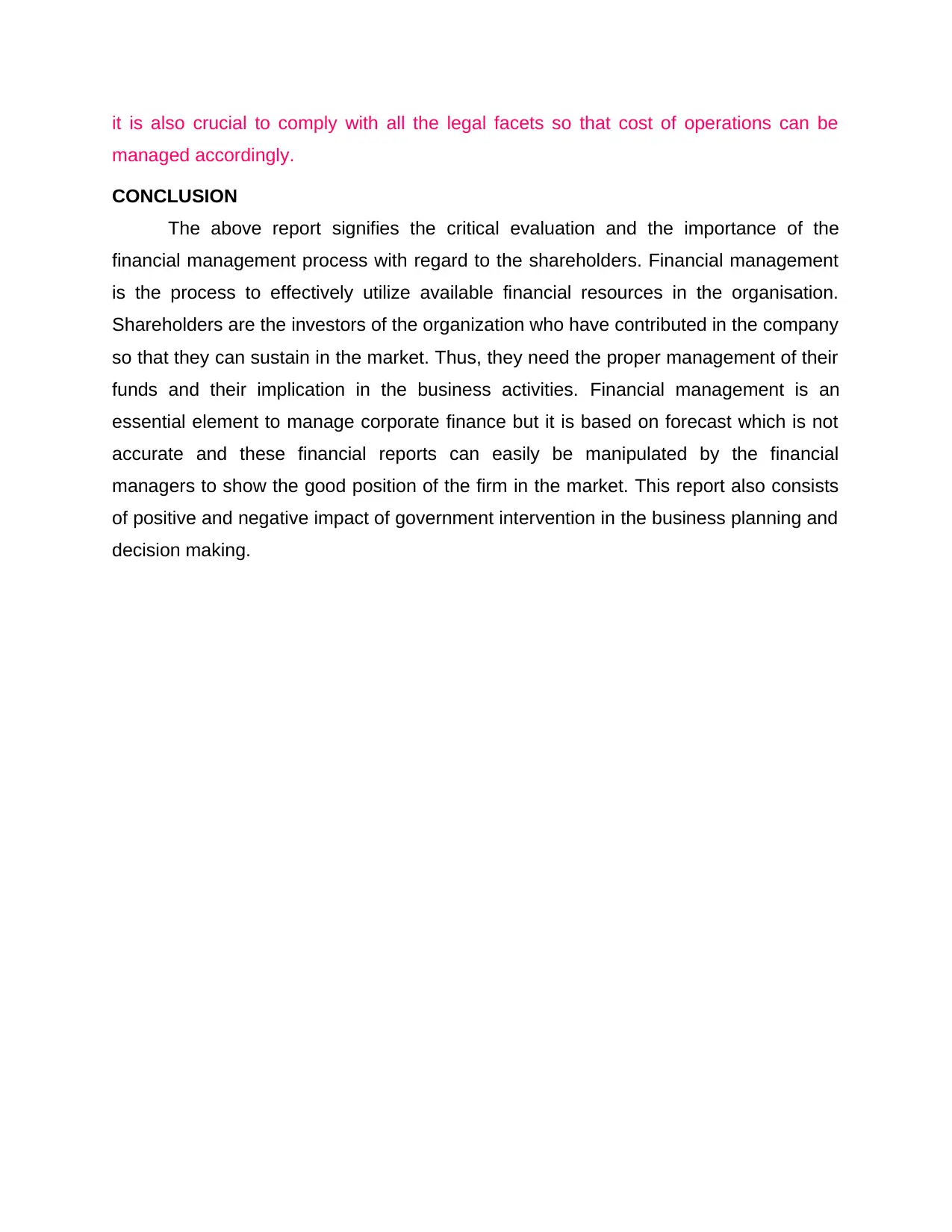
it is also crucial to comply with all the legal facets so that cost of operations can be
managed accordingly.
CONCLUSION
The above report signifies the critical evaluation and the importance of the
financial management process with regard to the shareholders. Financial management
is the process to effectively utilize available financial resources in the organisation.
Shareholders are the investors of the organization who have contributed in the company
so that they can sustain in the market. Thus, they need the proper management of their
funds and their implication in the business activities. Financial management is an
essential element to manage corporate finance but it is based on forecast which is not
accurate and these financial reports can easily be manipulated by the financial
managers to show the good position of the firm in the market. This report also consists
of positive and negative impact of government intervention in the business planning and
decision making.
managed accordingly.
CONCLUSION
The above report signifies the critical evaluation and the importance of the
financial management process with regard to the shareholders. Financial management
is the process to effectively utilize available financial resources in the organisation.
Shareholders are the investors of the organization who have contributed in the company
so that they can sustain in the market. Thus, they need the proper management of their
funds and their implication in the business activities. Financial management is an
essential element to manage corporate finance but it is based on forecast which is not
accurate and these financial reports can easily be manipulated by the financial
managers to show the good position of the firm in the market. This report also consists
of positive and negative impact of government intervention in the business planning and
decision making.
⊘ This is a preview!⊘
Do you want full access?
Subscribe today to unlock all pages.

Trusted by 1+ million students worldwide
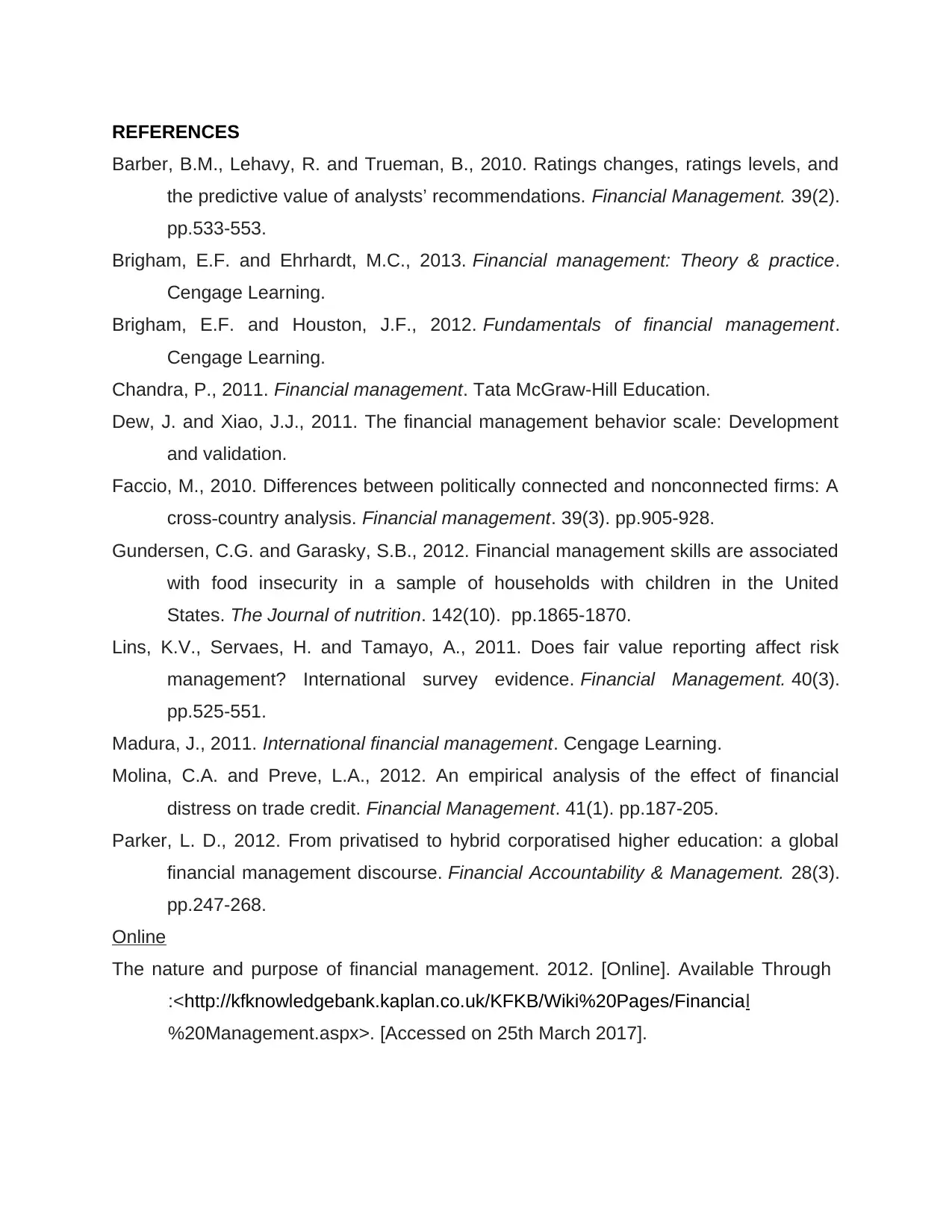
REFERENCES
Barber, B.M., Lehavy, R. and Trueman, B., 2010. Ratings changes, ratings levels, and
the predictive value of analysts’ recommendations. Financial Management. 39(2).
pp.533-553.
Brigham, E.F. and Ehrhardt, M.C., 2013. Financial management: Theory & practice.
Cengage Learning.
Brigham, E.F. and Houston, J.F., 2012. Fundamentals of financial management.
Cengage Learning.
Chandra, P., 2011. Financial management. Tata McGraw-Hill Education.
Dew, J. and Xiao, J.J., 2011. The financial management behavior scale: Development
and validation.
Faccio, M., 2010. Differences between politically connected and nonconnected firms: A
cross‐country analysis. Financial management. 39(3). pp.905-928.
Gundersen, C.G. and Garasky, S.B., 2012. Financial management skills are associated
with food insecurity in a sample of households with children in the United
States. The Journal of nutrition. 142(10). pp.1865-1870.
Lins, K.V., Servaes, H. and Tamayo, A., 2011. Does fair value reporting affect risk
management? International survey evidence. Financial Management. 40(3).
pp.525-551.
Madura, J., 2011. International financial management. Cengage Learning.
Molina, C.A. and Preve, L.A., 2012. An empirical analysis of the effect of financial
distress on trade credit. Financial Management. 41(1). pp.187-205.
Parker, L. D., 2012. From privatised to hybrid corporatised higher education: a global
financial management discourse. Financial Accountability & Management. 28(3).
pp.247-268.
Online
The nature and purpose of financial management. 2012. [Online]. Available Through
:<http://kfknowledgebank.kaplan.co.uk/KFKB/Wiki%20Pages/Financial
%20Management.aspx>. [Accessed on 25th March 2017].
Barber, B.M., Lehavy, R. and Trueman, B., 2010. Ratings changes, ratings levels, and
the predictive value of analysts’ recommendations. Financial Management. 39(2).
pp.533-553.
Brigham, E.F. and Ehrhardt, M.C., 2013. Financial management: Theory & practice.
Cengage Learning.
Brigham, E.F. and Houston, J.F., 2012. Fundamentals of financial management.
Cengage Learning.
Chandra, P., 2011. Financial management. Tata McGraw-Hill Education.
Dew, J. and Xiao, J.J., 2011. The financial management behavior scale: Development
and validation.
Faccio, M., 2010. Differences between politically connected and nonconnected firms: A
cross‐country analysis. Financial management. 39(3). pp.905-928.
Gundersen, C.G. and Garasky, S.B., 2012. Financial management skills are associated
with food insecurity in a sample of households with children in the United
States. The Journal of nutrition. 142(10). pp.1865-1870.
Lins, K.V., Servaes, H. and Tamayo, A., 2011. Does fair value reporting affect risk
management? International survey evidence. Financial Management. 40(3).
pp.525-551.
Madura, J., 2011. International financial management. Cengage Learning.
Molina, C.A. and Preve, L.A., 2012. An empirical analysis of the effect of financial
distress on trade credit. Financial Management. 41(1). pp.187-205.
Parker, L. D., 2012. From privatised to hybrid corporatised higher education: a global
financial management discourse. Financial Accountability & Management. 28(3).
pp.247-268.
Online
The nature and purpose of financial management. 2012. [Online]. Available Through
:<http://kfknowledgebank.kaplan.co.uk/KFKB/Wiki%20Pages/Financial
%20Management.aspx>. [Accessed on 25th March 2017].
1 out of 10
Related Documents
Your All-in-One AI-Powered Toolkit for Academic Success.
+13062052269
info@desklib.com
Available 24*7 on WhatsApp / Email
![[object Object]](/_next/static/media/star-bottom.7253800d.svg)
Unlock your academic potential
Copyright © 2020–2025 A2Z Services. All Rights Reserved. Developed and managed by ZUCOL.





